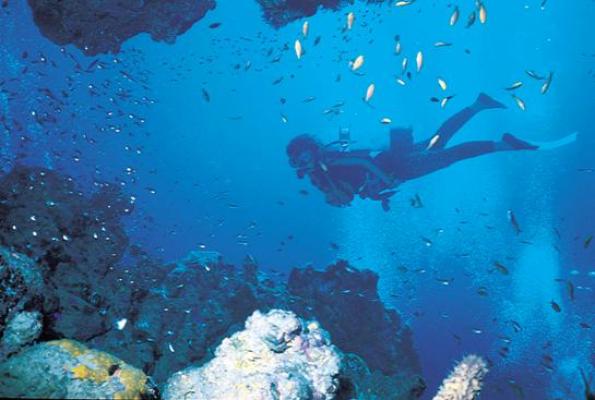

Whether you're interested in diving with great white sharks, whales, dolphins, around breathtaking coral reefs or in shipwrecks, South Africa has it all to offer.
The water temperature in South Africa ranges from the cold in the Western Cape waters to the much warmer waters of Kwazulu Natal.
The Mozambiquan current that flows down the eastern coast of South Africa brings warm tropical water down the coastline of Kwazulu Natal and so makes the waters ideal to spot all sorts of wildlife, from great white sharks to whales, whale sharks, dolphins, turtles, manta and eagle rays, and exquisite coral reefs too.
Sodwana in KwaZulu-Natal is home to the most southerly coral reefs in the world. When you come here to dive the wonderful reefs, do take note. A flight from sea level to Johannesburg can take only an hour, but with a gain of 2 000 metres (7 000ft) in altitude. This really is a major risk, so adjust your itinerary to include a day of sightseeing, shopping or beach lounging between diving and flying to Johannesburg.
There are dive schools in almost every centre in the country, so you could almost dive anywhere on the coast.
Kwazulu Natal is a good diving location, primarily for mantas, rays, sharks, whales, dolphins, turtles, reef and pelagic fish, hard and soft coral reefs, and wrecks.
Although Kwazulu-Natal has a large population of sharks, they pose little threat to scuba divers. No shark attack has ever been recorded on a scuba diver in the province.
Sodwana Bay is widely accepted as the Mecca of diving in South Africa. Sodwana is easily accessible, only four hours by car from Durban.
Sodwana is diveable all year round with the best conditions being experienced during the warm summer months from November to May.
The most scenic reef is 7 Mile, which on a good day can compare with the best in the world. Over 1 200 species of fish have been dentified at Sodwana Bay. Visibility is rarely less than 15 metres, and the water temperature in summer is 24C+ and in winter not colder than 19C. The depths vary between 12 to 18 metres with 30 and 50-metre sites for the suitably qualified.
After Sodwana Bay, Aliwal Shoal is the next most popular dive destination. Divers flock to Aliwal Shoal from around the world and sightings of the migrating ragged tooth shark can almost be guaranteed, especially from July to November.
Aliwal Shoal is a 40-minute drive south of Durban and lies off the small coastal town of Umkomaas. The shoal is a fossilised sand dune, and lies 5 km offshore. The wreck of the Produce, a Norwegian freighter that struck Aliwal Shoal in 1974, now rests in 30 metres of water and makes an interesting wreck dive.
For the adventure seeker, Protea Banks, situated 8 kms offshore from Shelly Beach, south of Port Shepstone, is a must. This is a deep dive starting at 25 metres where pelagic fish and the bigger sharks can be seen. The lucky diver may spot the potentially dangerous Zambezi, Tiger and Hammerhead sharks during the summer months, and ragged tooth sharks during winter.
Other diving spots include Margate, Durban and Umhlanga Rocks
The Cape Province is mostly good for wrecks, white sharks, kelp forests and colourful sponges. Diving in kelp is like walking in a forest. You float beneath the canopy and admire the surprisingly colourful reef life. There are only three major types of kelp, and a part of the Western Cape coast is the only place in the world where they all grow together!
Off Cape Town, divers regularly see anemones in colours ranging from electric blue or deep red to pale pink, nudibranchs of almost every colour you can imagine, and a whole range of small creatures in and around the bright orange and sulphur yellow sponges.
A dive with the Cape Fur Seals at seal Island near Hout Bay is an absolute must for visitors to the Cape. Depending on the time of year there are between a few hundred and a few thousand seals crammed onto the island.
Great White Shark Cage Diving can be done at Gansbaai where you can scuba cage dive this magnificent predator in its natural feeding ground.
Diving can be done at various spots along the Garden Route such as Knysna and Plettenberg Bay
In the Eastern Cape you'll find scuba diving centres at St Francis Bay, Jeffreys Bay and Port Elizabeth
The Wild Coast is renowned for its rugged scenery, but because of the long distances between towns, the poor condition of the roads, the lack of facilities and the reasonably strenuous diving, this region is suitable only for completely self-sufficient parties of experienced divers. It is a very popular destination for extended spearfishing trips.
There are a surprising number of dive schools in the landlocked Johannesburg area. Perhaps it's not so surprising: most people do their training up there and then take the 6 hour drive to Sodwana Bay for their qualifying dives.
There is even an inland dive resort near Johannesburg, where students can do their first dive or two in a disused quarry. Komati Springs is a much deeper disused quarry in Mpumalanga where rebreather, mixed gas and deep diving courses are run.


